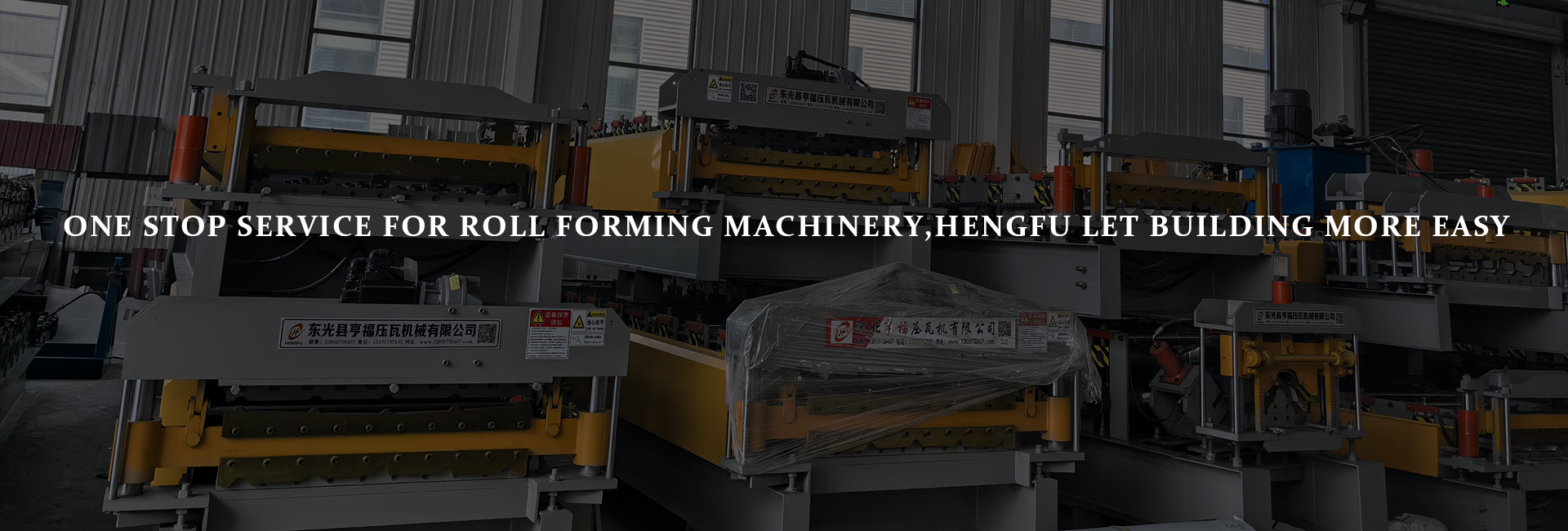In the construction industry, roof panel forming machines are the core equipment for producing metal roofing panels. Their stable operation directly impacts construction efficiency and project quality. However, prolonged high-load operation can lead to equipment wear, malfunctions, and other issues. Mastering scientific maintenance techniques not only ensures the efficient operation of the equipment but also significantly extends its service life. This article will share five key techniques for extending the lifespan of roof panel forming machines, helping you reduce operating costs and enhance production efficiency.
1. Introduction: The Importance of Roof Panel Forming Machine Maintenance
1.1 Market Demand for Metal Roofing and Equipment Dependency
With the widespread application of metal roofing in industrial plants, commercial buildings, and other fields, the usage frequency of roof panel forming machines continues to rise. The risk of wear and tear due to prolonged equipment operation makes maintenance work a critical link in safeguarding construction progress and quality.
1.2 Pain Points and Hidden Dangers of Neglecting Traditional Maintenance
Neglecting routine maintenance can lead to problems such as component aging, reduced precision, and frequent malfunctions. This not only results in decreased production efficiency and increased material waste but can also, in severe cases, trigger safety accidents, affecting project timelines and enterprise profits.
1.3 Core Focus of This Article: Analysis of Five Maintenance Techniques
Focusing on directions such as routine equipment care and maintenance of key components, this article delves into practical techniques for extending the lifespan of roof panel forming machines, providing users with a scientific maintenance guide.
2. Basic Understanding of Metal Roof Forming Machines: The Prerequisite for Maintenance
2.1 Equipment Definition and Functional Overview
Roof panel forming machines process metal sheets into roof panels of specific shapes through rolling processes, encompassing a series of automated procedures such as feeding, forming, and cutting. Their stable performance relies on the coordinated operation of various components.
2.2 Core Components and Their Maintenance Relevance
Rolling System: As the component directly in contact with the sheets, the rollers are prone to wear and deformation, affecting forming precision. Maintenance of this system requires special attention.
Transmission Device: Provides power for equipment operation. Lubrication and inspection of components such as bearings and chains are crucial for ensuring stable transmission.
Control System: Responsible for adjusting equipment parameters and monitoring operation. Maintenance of electronic components against moisture and dust is vital for system stability.
2.3 Differences in Maintenance for Mainstream Machine Types
Different types of roof panel forming machines (e.g., single-layer/double-layer, semi-automatic/fully automatic) have structural and operational differences, leading to variations in maintenance priorities and frequencies. Maintenance plans should be tailored according to machine characteristics.
2.4 Technical Parameters and Maintenance Indicators
Technical parameters such as forming speed and sheet material applicability affect equipment operating loads. Maintenance should合理安排设备工作强度 (reasonably arrange equipment work intensity) based on these parameters to avoid accelerated component wear due to overloading.
3. Five Key Maintenance Techniques to Extend Equipment Lifespan
3.1 Regular Cleaning: The Foundation for Maintaining Equipment "Health"
Surface Cleaning: After daily production concludes, promptly remove any residual metal shavings, dust, and other debris from the equipment surface. This helps prevent these contaminants from infiltrating the equipment, which could otherwise cause wear and tear on transmission components or disrupt the normal functioning of the control system.
Internal Cleaning: Periodically open the equipment's protective covers to perform thorough cleaning of critical components such as the rolling system and transmission device. Utilize specialized tools to eliminate built-up oil and grime, as well as any other impurities, thereby ensuring the smooth operation of these parts.
3.2 Precise Lubrication: The Key to Reducing Component Wear
Lubrication Cycle: Develop a scientific lubrication cycle based on equipment usage frequency and operating conditions. Generally, components such as roller bearings and transmission chains require lubrication once a week. Special components should follow the equipment manual.
Lubrication Points: Select appropriate lubricants and ensure even application to avoid excessive lubrication leading to oil buildup. Regularly check oil levels at lubrication points and promptly replenish or replace lubricants.
3.3 Component Inspection and Replacement: Preventing Problems Before They Occur
Daily Inspections: Operators should closely monitor the operating status of various components during equipment operation, using methods such as listening for sounds and observing vibrations to detect abnormalities. If issues like abnormal roller noise or transmission device shaking are detected, the equipment should be immediately shut down for inspection.
Regular Overhauls: Conduct comprehensive overhauls of the equipment monthly or quarterly, focusing on inspecting roller wear levels, the tightness of transmission components, and the sensitivity of the control system. Promptly replace severely worn or aged components to prevent minor issues from escalating into major faults.
3.4 Standardized Operation: Reducing Human-Induced Wear
Pre-Job Training: Operators must undergo professional training to familiarize themselves with the equipment's operating procedures and precautions. Strictly follow operating procedures to start, operate, and stop the equipment to avoid damage due to misoperation.
Avoiding Overloading: Arrange production tasks according to the equipment's technical parameters and performance. Strictly prohibit prolonged overloading. When changing sheet materials of different specifications, readjust equipment parameters to ensure optimal operation.
3.5 Environmental Management: Creating Favorable Conditions for Equipment
Temperature and Humidity Control: The operating environment's temperature and humidity significantly impact equipment performance. Place the equipment in a dry, ventilated environment to prevent high temperatures and humidity from accelerating component corrosion and aging.
Dust and Moisture Prevention: Install dustproof facilities around the equipment to prevent dust from entering. For electronic components such as the control system, implement moisture-proof measures, such as adding moisture-proof boxes or using desiccants, to ensure normal operation.
4. Extended Suggestions for Maintenance and Usage
4.1 Establishing Maintenance Archives: Recording Equipment "Health History"
Create detailed maintenance archives for each roof panel forming machine, recording the time, content, and replaced components of each maintenance session. Analyzing maintenance data can help predict equipment failures in advance and optimize maintenance plans.
4.2 Paying Attention to Industry Standards and Technological Updates
Stay informed about industry maintenance standards and new technologies for roof panel forming machines. Apply advanced maintenance concepts and methods to practical work to enhance the scientific and effective maintenance of equipment.
4.3 Strengthening Maintenance Awareness and Team Collaboration
Enterprises should enhance training for operators and maintenance personnel to raise everyone's maintenance awareness. Establish a communication mechanism between operators and maintenance personnel to ensure that equipment issues are promptly reported and resolved.
5. The Impact of Industry Trends on Maintenance
5.1 Growing Demand for Intelligent Maintenance
With the increasing intelligence of roof panel forming machines, future equipment will possess stronger self-monitoring and diagnostic capabilities. Maintenance work needs to transition towards intelligence, achieving precise maintenance through data analysis and reducing maintenance costs.
5.2 Popularization of Green Maintenance Concepts
The application of green and environmentally friendly technologies in equipment requires maintenance work to place greater emphasis on resource conservation and environmental protection. For example, using environmentally friendly lubricants and properly disposing of maintenance waste can promote the sustainable development of maintenance work.
5.3 Upgrading of Maintenance Service Systems
Market competition prompts equipment suppliers to continuously improve their after-sales service systems. In the future, enterprises can leverage the technical support of suppliers to obtain more professional and efficient maintenance services, further ensuring the stable operation of equipment.
6. Conclusion: Scientific Maintenance Achieves Long-Term Equipment Value
The maintenance of roof panel forming machines is a long-term and systematic project. Mastering the above five key techniques and combining them with equipment characteristics and actual operating conditions for scientific maintenance can effectively extend the equipment's lifespan and reduce enterprise operating costs. In the current rapid development of the construction industry, prioritizing equipment maintenance lays a solid foundation for the sustainable development of enterprises. If you wish to further explore maintenance details or equipment selection advice for roof panel forming machines, welcome to delve into more professional content and let the equipment create greater value for production.







